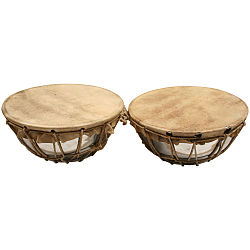


Iraqi Naqqarat
| |
| Other names | Naqqārat, naqqare, nakkare, nagora, نقاره |
|---|---|
| Classification | |
| More articles or information | |
The naqareh, naqqāra, nagaraornagada is a Middle Eastern drum with a rounded back and a hide head, usually played in pairs. It is thus a membranophone of the kettle drum variety.
The term naqqāra (نقاره), also نقارات naqqarat, naqqarah, naqqåre, nakkare, nagora comes from the Arabic verb naqr- that means "to strike, beat".
The instrument was also adopted in Europe following the Crusades, and known as the naccaireornaker.
The rounded section of a naqqara is made of baked clay, while the flat side consists of treated skin fastened around the rim with string which is tightened over the back of the bow
This percussion instrument is often played in pairs, where one naqqara will produce low pitch beats called nar and the other for the high pitch beats. The instruments are beaten with short wooden sticks bent outward at the upper ends called damka.
Naqqārāt is the name of kettledrums in Arabic countries. Naqqārāt, hemispherical with the skin stretched over the top, come in pairs. Naqqarat is one of the percussion instruments used in Maqam al-Iraqi chalghi ensembles. Under the late Abbasids and the Fatimid Caliphate, kettledrums were beaten before the five daily prayers; small ones form part of present-day orchestral ensembles.
Naqqåre can be found in different sizes in different regions of Iran:

Naqqara are also found in India, where the word is pronounced nagaraornagada. They are paired kettledrums traditionally used in the naubat "Nine Things", a traditional ensemble of nine instruments. Nagara are also played with sticks. Today, this instrument is usually used to accompany the shehnai or "Indian oboe", an indispensable component of any North Indian wedding.
It was also used during Guru Gobind Singh Ji’s time as a war drum (first mentioned in the Battle of Banghani). This was to infuse pride into the Sikh armies while charging. It can be seen now usually at a Sikh martial art display (Gatka display) playing in the background.
Rebecca Stewart's unpublished thesis, The Tabla in Perspective (UCLA, 1974) has suggested tabla was most likely a hybrid resulting from experiments with existing drums such as pakhawaj, dholak, and naqqara.

In Azerbaijan there is a kind of kettledrum that is called ghosha-naqara. Ghosha means "pair".[1]
In Turkey, this word is pronounced nakkare and refers to small kettledrums beaten with the hands or two sticks. Kös, or giant kettledrums played on horseback, are a separate instrument. These drums and the davulorcylindrical drum were used in Ottoman mehter music.
In Uzbekistan the kettledrum is called naqaraornagora. Dulnaqara: a large kettledrum that gives a low and loud sound (i.e. "tum"). Reznaqara is a small kettledrum that gives a high and loud sound (i.e. "tak"). Koshnaqara is a small-paired kettledrum, a pair of clay pots with goatskin tops.

Kettledrums were adopted in Europe during the 13th century Crusades, following contact with Saracen musicians who played the drums;The Arabic term naqqara became French nacaires, the Italian naccheroni and the English nakers. The instrument spread rapidly, reaching England in the 14th century. The instrument is very visible in European artwork and iconography of the period, before fading from view in the 17th century.[2]
As the Grove Dictionary of Music describes them:
They were more or less hemispherical, 15-25cm in diameter, frequently with snares and usually played in pairs, suspended in front of the player. They were usually played with drumsticks, mainly for martial purposes but also in chamber music, dance and processional music and probably for accompanying songs.[3]
Kettledrums in Europe today are called tympaniortimpani, descended from the imported naqareh.[4]

Diplipito is a widespread percussion instrument all over Georgia. It comprises two small cone-shaped clay pots (jars) of the same height, but different width, which are covered with leather. One of the clay pots is smaller than the other. A cord ties the two jars together. The height of the jars is 200-250 mm, and their diameters are 90mm and 170mm. The diplipito is played with two small sticks called "goat legs." The instrument is used to provide rhythms for vocal music and dance music. It is often combined with instruments such as duduki, buzika panduri, and salamuri. The diplipito is generally played by males, and plays an important role in Georgian folk ensembles.
|
| |
|---|---|
| Wind (Sushir) |
|
| Plucked Stringed (Tat) |
|
| Bowed Stringed (Vitat) |
|
| Membranous Percussion (Avanaddh) |
|
| Non-Membranous Percussion (Ghan) |
|
| Other |
|
| Historical/possibly extinct |
|
|
| |||||||||
|---|---|---|---|---|---|---|---|---|---|
| Stringed (Sāzhāy-e Zehī) |
| ||||||||
| Woodwind (Sāzhāy-e Bādī) |
| ||||||||
| Brass |
| ||||||||
| Percussion (Sāzhāy-e Kūbeheyī/Zarbī) |
| ||||||||
Afghan traditional music | |||||||||
|
| |
|---|---|
| String instruments |
|
| Woodwind instruments |
|
| Percussion instruments |
|
| See also |
|
| |
|
| |
|---|---|
| String instruments |
|
| Woodwind instruments |
|
| Percussion instruments |
|
| Possibly extinct |
|
| See also |
|